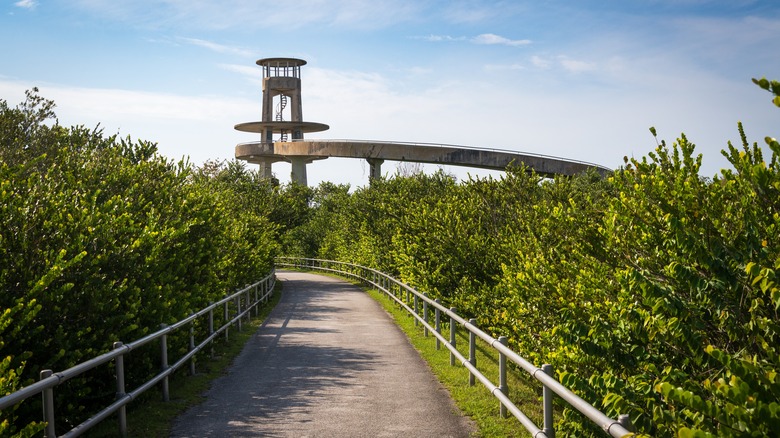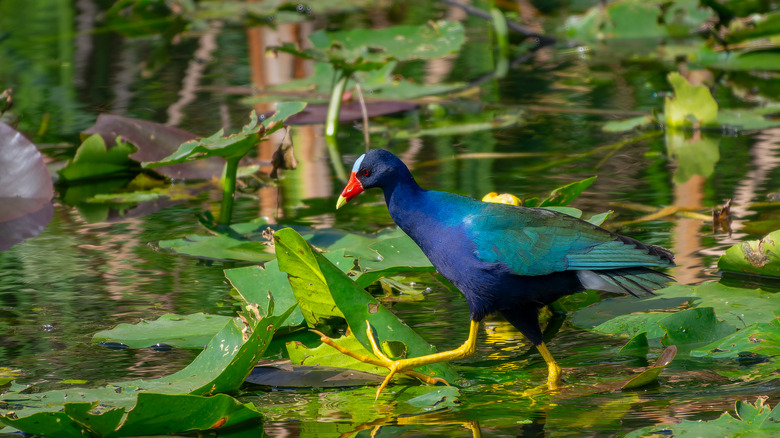Florida's Popular National Park Is Full Of Unique Scenery And Wildlife
Mention the Florida Everglades and images of swamps and alligators immediately come to mind. It is, after all, one of the five most alligator-filled destinations in Florida. However, many visitors to this subtropical destination are surprised to learn just how accessible this prehistoric ecosystem truly is. Because, despite its seemingly impenetrable landscape, Everglades National Park provides plenty of opportunities to see its wildlife and its sprawling scenery up close — with or without a boat.
Covering 1.5 million acres, a surprising portion of Everglades National Park is accessible by car and on foot. Strategically placed overlooks and boardwalks dot the area, making it possible for visitors to park and explore on their own. As for airboat tours, there are only three companies with permission to operate within the park, and they're all located near Miami — just an hour's drive away from the park's borders.
As the third largest park in the continental United States, Everglades National Park is both a Biosphere Reserve and a UNESCO World Heritage Site. Three public entrances provide seamless entry into the park, making navigation easier and access to the biodiversity here even more attainable. Although these aren't located near one another, they do offer impressive access to different areas. On one hand, the Everglades City entrance, near Naples, serves Florida's Gulf coast. Meanwhile, the Shark Valley entrance in Miami boasts an elevated viewing deck. Finally, the main entrance to the park — located in Homestead, Florida, which is considered one of the most fun and unique towns near a national park — also offers access to Royal Palm State Park and the Guy Bradley Visitor Center. Each entrance offers different experiences and access options, so it's important to know what's available when you plan a trip.
Choosing the right entrance for visiting Everglades National Park
At the park's main entrance in Homestead, a visitor center welcomes guests 365 days a year, providing easy access to many popular walking and biking trails. The trails near this entrance are divided into two groups, all at varying lengths. While the Pine Island Trails are often smoother and wheelchair accessible, the Flamingo Trails are not. To determine which experience is best for your visit, the park recommends downloading its official trail brochures in order to plan your route.
One of the most popular attractions in Everglades National Park is Shark Valley's observation tower, pictured above. It stands out not only for its 360-degree bird's eye view of the wildlife and terrain, but also for its accessibility: A sloped ramp makes it easier to climb. Additionally, visitors are also welcome to explore the area accessible via this entrance on foot or by bicycle. Don't feel like walking? The only motorized vehicles allowed past the parking lot are operated by Shark Valley Tram Tours. These ticketed excursions offer a two-hour, open-air ride through the park alongside an expert guide who will point out interesting features and wildlife.
Finally, although the Everglades City entrance is closed as of this writing, the area is slated to debut a new visitors center in Fall 2025 after its original visitor center was destroyed during the 2024 hurricane season. Some parts of the park here also remain closed due to storm damage. However, two-hour guided boat tours are still available through Everglades National Park Adventures — the only company authorized to offer commercial boat tours. Kayak tours along the Wilderness Waterway, a 99-mile navigable waterway, are also expected to resume sometime during the 2025 winter months. That said, before traveling to any of the park's entrances, it's important to be aware of any ongoing projects that could cause closures via the park's official website.
The Everglades are teeming with wildlife
American alligators are typically the most sought-after wildlife for visitors to the park. This is not surprising, since wildlife experts estimate there are at least 200,000 of them in Everglades National Park. Crocodiles also live here, and the Everglades is the only known place on earth where alligators and crocodiles co-exist. Fortunately, these prehistoric reptiles don't feed on humans. Nonetheless, they can still be territorial and will protect themselves and their young, so it's important to keep a safe distance.
The unique ecosystem also attracts both marine and land animals, as well as more than 750 native plant species that thrive here. Manatees are often spotted in the fresh-water areas, and a variety of turtles warm themselves on sunny days. While the Everglades mostly consists of marshy wetlands, there are land-living animals to spot on a trip here, too. The Florida panther calls this vast wilderness home, and conservation groups estimate that there are at least 350 different bird species living within the park. At the most recent count, a total of 36 endangered or protected native plant and animal species live together in Everglades National Park.
As such, it's no surprise that swimming is strictly prohibited in the Everglades. Considering it's among Florida's most snake-packed waters, you probably won't want to jump in the water anyway. Visiting the park is encouraged year-round, but it's a more comfortable experience in the dry season, between December and April, when temperatures are cooler and bugs are less prevalent. The wet season, which runs from May to November, means that crowds are typically smaller — but it's also when temperatures tend to soar. No matter when you choose to visit, keep in mind that public facilities are limited, and that approaching any wildlife is strictly prohibited.


